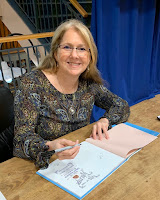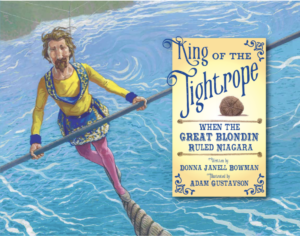Are you following February’s fabulous and free Nonfiction Fest, described as a month-long crash course in writing children’s nonfiction? I was honored to contribute the following blog post about creative structures available to picture book biography writers. I hope you enjoy it.
Choosing a Structure for Your Picture Book Biography
By Donna Janell Bowman
Dear reader-writer, I understand the struggle. Writing picture books is challenging. Informational picture books and picture book biographies can be especially toilsome because of the research and the challenge of artistically shaping facts into a picture-book-sized narrative. My own stacks of saved (I don’t know why) revisions are evidence of the struggle. And I’m not alone. In my coaching, critiquing, and teaching of kidlit writers, I’ve noticed that a few specific craft elements cause exceptional angst, especially with narrative biographies. Among them is structure.
There are several ways to define literary structure. For today’s purposes, I’m referring to how you order or arrange your text to customize your storytelling. Yes, I said storytelling. And, yes, I’m talking to you. Remember that you are not writing facts, you are writing a factual story. That’s why it’s called narrative nonfiction. Publishers and their respective editors might have house styles that influence their preferences, but there’s no doubt that a fresh approach can make the difference between a rejection and acquisition. So, let’s think outside the box and get creative.
Before You Choose Your Biography Story Structure,
Know Your Story
* What point of view will you use?
* What is the scope of your narrative—your character’s entire life or a specific time period?
* What makes your character notable? An invention, a creation, activism, an exceptional accomplishment?
* What kind of action and obstacles are involved in your narrative arc?
* What are the primary themes of your narrative? In other words, what inspiring message or character traits will readers glean from your tale?
* What tone and voice will best capture your character’s spirit on the page?
* What age range is most appropriate for your story, 6-8 or 8+?
There are no prescribed rules about structure, but the following are some options—
Linear – The good ole classic chronological approach – Point A to Point Z (not necessarily an entire life). Examples include Jen Bryant’s The Right Word: Roget and His Thesaurus, illustrated by Melissa Sweet, and Cynthia Levinson’s Youngest Marcher: The Story of Audrey Faye Hendricks, illustrated by Vanessa Brantley-Newton
Reverse Chronology – How about a story structured from ending to beginning—or from the character’s old age to their youth? That’s how Lesa Cline-Ransome crafted her verse biography Before She Was Harriet, illustrated by James Ransome.
Basic Non-Linear – You can rearrange the chronology for storytelling purposes, as long as you don’t confuse your reader. For example, as a hook, begin with a mid-scene, mid-action segment from what would be Act II or III, and then a flashback to fill in relevant backstory. From that point, you could intersect the narrative with that opening scene and carry it through to the story’s end. Adjust your structure to fit your story. Examples include Laurie Wallmark’s Grace Hopper: Queen of Computer Code, illustrated by Katy Wu, and my newly released King of the Tightrope: When the Great Blondin Ruled Niagara, illustrated by Adam Gustavson.
Alternating Time & Tense – This tricky non-linear approach works especially well with high-drama stories or interesting points of view. Often, the narrative alternates between present tense and past tense. I chose this structure with my book Abraham Lincoln’s Dueling Words, illustrated by S.D. Schindler, as did Leda Schubert with Monsieur Marceau, illustrated by Gerard Dubois.
Episodic – Rather than a single narrative, this rare approach includes disconnected episodes, with a common theme. See Elvis is King by Jonah Winter and Red Nose Studio for an example.
Parallel Structure – Do two bio characters share the stage in your story? Consider a parallel structure, as Andrea Davis Pinkney did with Martin & Mahalia: His Words, Her Song, illustrated by Brian Pinkney. Or perhaps a metaphorical comparison between a character and a natural phenomenon, as Hannah Holt did with The Diamond and the Boy: The Creation of Diamonds & The Life of H.Tracy Hall, illustrated by Jay Fleck.
Concept Structure – Related to Episodic, this structure capitalizes on the character’s achievements. A biography about a baseball player could be structured in innings, an actor’s story could unfold in Acts, an athlete’s story could be revealed by laps, etc. Take a look at Alan Schroeder’s and John O’Brien’s Abe Lincoln: His Wit and Wisdom from A-Z—an alphabet book. Or Jonah Winter’s book, Ruth Bader Ginsburg: The Case of R.B.G. vs. Inequality, illustrated by Stacy Innerst, which is structured as a court case. See how clever that is?
Verse – Verse and rhyme don’t only fall into the Voice category. Poetry has structure. If your story is poignant, elegant, fluid, or extremely emotional, free verse can be a powerful option. Consider how the lyrical verse approach to Swan: The Life and Dance of Anna Pavlova, by Laurel Snyder and Julie Morstad, complements the fluidity of the ballet subject. Likewise, Bethany Hegedus’ Rise: From Caged Bird to Poet of the People, illustrated by Tonya Engel reflects the poetry of Maya Angelou.
Rhyme – Rhyme can give life to an otherwise dry topic, or it can mirror the liveliness of a character. Kathleen Krull chose rhyme for her rollicking picture book biography, Fartiste: An Explosively Funny, Mostly True Tale (which is, in fact, 100% factual), illustrated by Paul Brewer. Can you imagine a more fitting structure for a flatulence artist? As an example of the versatility of rhyme, Julia Finley Mosca chose rhyme for The Girl with a Mind for Math: The Story of Raye Montague, illustrated by Daniel Rieley.
There are no templates or rules for writing a picture book biography, and there’s no limit to the creative structures that could be imagined. Picture books are an art form and writers are half of the artistic team behind them. Go ahead and experiment with the structure of your narrative. You might just elevate your storytelling, bring your character to life, and slay that nagging angst.



Donna:
As you pointed out, there are no rules or templates for structuring a nonfiction manuscript. The nine structures you shared are excellent ways to begin building and organizing a story. I appreciate the pb titles that correspond with each suggested structure–all excellent mentor texts.
The first annual Nonfiction Fest is an amazing toolbox for nonfiction writers.
Thank you.
Suzy Leopold